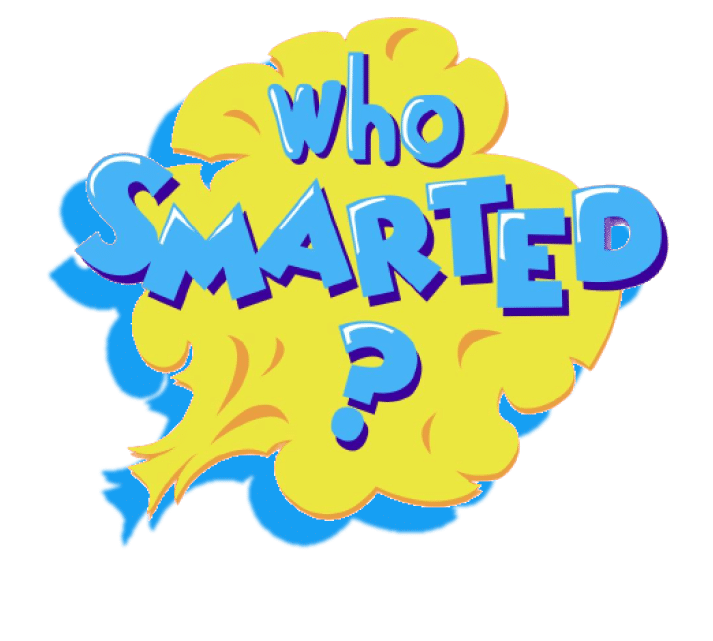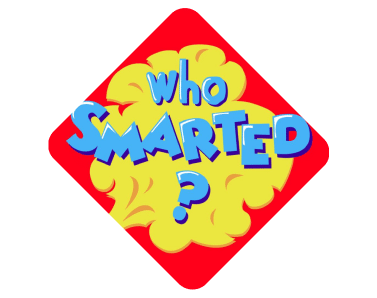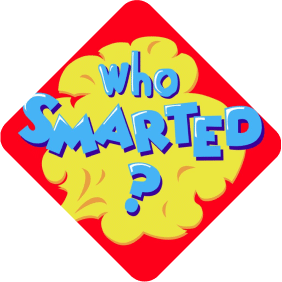What Are Crayons Made Of?

Narrator: Hey Smarty Pants, quick question. Do you like to draw?
Speaker 2: All right, partner, you count 10 paces, turn and draw.
Narrator: No, I don’t mean draw like in the old west. I meant drawing like a picture.
Speaker 2: That’s what I meant too. Go 10 paces over there. You’ll find yourself some paper. Then turn and draw some. I’m going to draw me a picture of my doggy.
Narrator: That’s better. Me personally, I like it when someone else draws and I get to color it in mostly inside the lines, but not always. And what is my preferred method of coloring Smarty pants? Any guesses? I heard colored pencils, markers, dry erase markers. All good answers, but none of them the right answer. That’s because for me, the best way to color something is with a crayon.
I just love crayons. In fact, I was just getting ready to open a new box of crayons I bought at an arts and craft store. Here it goes.
Hello Crayons.
Speaker 3: Hello.
Speaker 4: Who’s there?
Speaker 5: What’s up?
Speaker 6: Howdy
Speaker 7: Holla
Narrator: Well. I wasn’t actually expecting you to talk.
Speaker 4: Hey, trusty narrator. The name’s Violet. And I think I speak for the entire box when I say how excited we’re to be on Who Smarted??.
Speaker: I was actually going to do today’s episode on crayons, but since you’re here and you can talk, maybe you wouldn’t mind helping me out.
Speaker 3: Sure.
Speaker 4: Great.
Speaker 5: Definitely.
Speaker 6: Why not?
Speaker 7: You got this, Violet.
Speaker 4: It would be our pleasure to help you in the smarty pants learn about the colorful world of crayons. What would you like to know?
Narrator: Well, I think we’d all love to know what are crayons made of and how do they get their colors and what inspired all the fun and crazy crayons colors in the first place. And what did kids color with before Crayons?
Speaker 4: That’s easy, color us excited.
Narrator: Great. Then it’s time for a colorful whiff of science and history on Who Smarted??. Who smarted? Who smarted? Is it you? Is it me? Is it science or history? Listen up everyone we make morning lots of fun on Who’s Smarted?
Narrator: Hey Smarty Pants, how often do you use crayons to color in something? It could be a project for school or a coloring book for fun. Or to leave a note reminding everyone, you’re out of cookies. That reminds me, I’m out of cookies. Mind if I borrow you for a second Violet to leave myself a note.
Speaker 4: No problem.
Narrator: I bet some of you Smarty Pants use crayons a lot. And why wouldn’t you? There are so many awesome colors to choose from. It makes me wonder, where do the crayons creators get ideas for crayon colors?
Speaker 4: Here’s the hint, I’m named after a flower.
Narrator: What do you think? Smarty pants are crayons colors mostly inspired by:
A- Nature
B-TV or
C-Video Games.
If you said A, Nature, you are right. While inspiration can come from anywhere, crayons have been around much longer than TV or video games. Nature also has many bright and beautiful colors that would be right at home in a box of crayons. But who helped to create the crayons you know and love today Violet?
Speaker 4: Okay, Smarty Pants. Sit back as I tell you this colorful tale.
In 1866, a man named Edwin Benny was born. As Edwin grew up, he noticed the world of colors around him. But at work, the only color he saw was black because he worked at a company that sold carbon, black, and material used in ink and paint for things like vehicle tyres. In his spare time, Edwin and his cousin C. Harold Smith liked inventing things like a grey slate pencil that wrote extra smoothly white chalk that wasn’t dusty and didn’t crumble and the black wax crayon that could write on wood and paper packaging.
Narrator: Those sound like helpful inventions, but not very colorful. What did kids use back then when they wanted to draw a colorful picture?
Speaker 4: Crayons in the late 18 hundreds were big, dull, and hard to work with. Some people use lumps of colored clay to draw, but those only made thick lines. Artist’s crayons could be imported from Europe, but they were super expensive and broke easily. But the cost wasn’t the worst thing about early crayons. The worst thing was some were poisonous.
Narrator: Yaiks! What about Edwin’s other invention like the grey slate pencil?
Speaker 4: Grey slate pencil rubbed off too easily. Hey, where’s my cat drawing go?
Narrator: What about the white chalk?
Speaker 4: White chalk smudged? It was a cat, but now it just looks like a cloud.
Narrator: And let me guess, kids didn’t want to use Edwin’s black wax crayons because they wanted to draw in color.
Speaker 4: Exactly. So Edwin Benny and C. Harold Smith decided to come up with a way to make crayons that represented all the colors they saw in nature.
Narrator: Smarty Pants. Any idea where crayons get their different colors from? Is it
A, Paint
B, Pigment powders, or
C, A rainbow? If you said a rainbow, you’re probably thinking about the colors that crayons come in. But the right answer is B pigment powders.
Speaker: 4 Edwin C. Harold Smith and their team tried different mixes of pigment powders to make different colors. Slate powder was used to make grey, red iron oxide powder made red yellow iron oxide powder made yellow. Different shades of red iron oxide made brown, zinc oxide made white and imported lapis made blue.
Narrator: Wow! And just so you know, Smarty Pants, lapis lazuli or just lapis is a blue rock used to make gemstones as well as pigments.
Speaker 4: The workers making these early crayons would come home covered in
Narrator: Rainbow
Speaker 4: Pretty much. And using different combinations of pigments, heated and cooled to different temperatures, made lots of different shades.
Narrator: Which is why there are so many different shades and colors in a crayons box?
Speaker 4: Exactly, Trusty. Chemists begin blending different pigments and clays to make lots of oranges, greens, pinks, and of course, me violet.
Narrator: Just like mixing paint to get a new color. What were those early crayons made of?
Speaker 4: Crayons were mostly made of melted wax with some clay to thicken them and colored powders in just the right amount. But shh… the formula’s top secret
Narrator: Shushing.
Speaker 4: In June of 1903, Edwin Benny and C. Harold Smith invented a new kind of colored crayon.
Narrator: Smarty Pants. What was the name for this new kind of crayon? Was it
A- Cray Cray
B-Color stick or
C,-Clayola. Why Clayola?
Speaker 4: The name comes from clay, the French word for stick of chalk and ola from the word oleaginous, which means oily like the texture of the crayon wax.
Narrator: Very cool. Smarty Pants, any ideas what colors were in the original box of Crayola crayons? Let’s play a guessing game to find out. I’ll call out a color and you guess if it was in the original box of Crayola Crayons. A ding means yes and a buzz means no. Here we go.
Red, yellow, magenta, green, gold, pink, orange, brown, white, black, violet.
Speaker 4: I made the first box. Once again, the first crayon boxes had eight colors. Red, orange, yellow, green, blue, brown, black and the violet and it only cost a nickel.
Narrator: Wow! Does anything cost a nickel these days?
Speaker 4: Children immediately like these new crayons because the bright colors didn’t smudge or rub out. Finally, a good cat picture and kids have been drawing with crayons ever since. Of course, crayons are made a lot differently today.
Narrator: Smarty Pants, you’ll get to learn the secret to crayon making right after this quick break.
Commercials
Hey, Smarty Pants, want to know one of my favorite sounds? Here it is. That’s the sound I hear when I’m learning a new language with Babble. And if you want to learn a new language this year, I guarantee it’ll be one of your favorite sounds too. Learning a new language has always been on my to-do list, and thanks to Babble, I can check it off. But it’s not just about memorizing words, it’s about understanding a culture, connecting with other people on a deeper level and expanding my horizons.
With Babble’s quick 10 minute lessons designed by over 150 language experts. I was able to get the hang of the basics of German in only three weeks. Babble is convenient, effective, and genuinely fun. Best of all, Babble has equipped me with real life conversation skills, making it easy to order food, ask for directions, or shop in stores. Plus, Babble’s speech recognition technology has been a game changer for my pronunciation. Helping me sound like a local or close to it [Foreign language10:52] Babble. Here’s a special limited time deal for our listeners. Right now, get 50% off a one-time payment for a lifetime Babel subscription, but only for our listeners at babble.com/smart. Get 50% off at Babble.com/smarted. Spelled B-A-B-B-L-E.com/smarted. Rules and restrictions may apply.
This message is sponsored by Green Light. Hey, parents and guardians. Let’s talk about something crucial financial literacy for our kids. It’s a conversation that’s as important as any other childhood milestone. When I was a kid, I’d earn money doing chores with little to no understanding of what to do next. I’d stash my cash in a piggy bank but didn’t know why. I certainly didn’t know much about saving or budgeting if only Green Light was around to give me the opportunity for hands-on financial learning. You see, Green Light is a debit card and money app designed specifically for families. You can send your kids instant money transfers, get real time notifications of spending, manage chores, and automate allowance all while they learn how to handle money responsibly.
With Green Light kids learn about saving for goals, budgeting for their wants and needs, and understanding the value of money. Yes much better than just sticking money in a piggy bank. So stop putting off the money talk and start putting your kids on the right path. Sign up for Green Light today and get your first month free at Green Light.com/smarted. That’s Green Light.com/smarted .To try Green Light for free-greenight.com/smarted.
Now back to Who Smarted???
Narrator: So Violet, how are crayons made today?
Speaker 4: Well, Trustee narrator, they’re still made of wax, paraffin wax to be exact. This wax is heated and melted into a clear liquid, which is stored away in tall silos until it’s ready to be pumped inside the factory. That’s where the real magic happens.
Narrator: Cool. What do you think happens inside the crayon factory Smarty Pants? I could tell you, or we could teleport to a factory and ask someone to explain. Let’s do that. That sounds more fun. Excuse me. Would you mind?
Speaker5: What? Explaining how crayons are made
Narrator: How did you know that’s what?
Speaker5: Come on. Nobody teleports into a crayon factory because they don’t want to know how crayons are made anyway, the way it works is like this:
We pour the color pigments into vats full of liquid wax; add clay to thicken it and mix. The mixture gets pumped into a mold that looks like a giant round muffin tin. From there, the mixture fills all the small crayon shaped holes in each section. Next, we cool the wax with cold water and it eventually hardens into crayons.
Finally, the new crayon gets pushed up and out of the mold and a robotic arm takes them to the labeling machine.
Narrator: Wow! Who knew? Robots helped make Crayons?
Speaker 4: Like I said, a lot changed. Sincerely days of crayon making at the labeling machine, pre-printed sticky labels are wrapped around each crayon.
Narrator: And how do crayons get into their boxes?
Speaker5: Robots. The finished labeled crayons get sorted by a machine and dropped onto a conveyor belt. One robotic arm opens the empty crayon boxes while another arm pushes them inside and seals it up. And then off they go to be enjoyed by people all over the world.
Narrator: They sure are Smarty Pants. Crayola makes about 3 billion crayons a year. If all those crayons were placed end to end, they would circle the earth six times. That’s not all. By the time the average child is 10 years old, they’ll have worn down around 720 crayons. That’s a lot of coloring.
Speaker 4: It sure is. So Trusty, before you get started drawing with your magic crayons, do you have any more questions?
Narrator: Just one more. What crayon color is the most popular?
Speaker 4: Good question. Unfortunately, even though I’m perfect for drawing flowers or grapes, it’s not me.
Narrator: Smarty pants. What do you think is the most popular crayon color? Blue, red, or green? The answer is blue with red coming in a close second, but I think I’ll use Violet for my cookie reminder sign.
Speaker 4: Awwn, well, no matter what colors you like to use, crayons inspire people of all ages to be creative. Crayons have been featured in lots of storybooks, like the day the crayons quit. Read a crayon story, Harold, and the purple crayon and the crayon box that talked.
Narrator: So you aren’t the only talking crayons box.
Speaker 5: Nope.
Speaker 3: Guess not.
Speaker 4: No way.
Speaker 6: Uh-uh. Not even close.
Outro
A big shout out to Dylan and his dad, Tim, in Toronto, Ontario, Canada, thanks for listening to Who Smarted?? every night. We’re glad we helped make bedtime a breeze and we can hear you answering all the questions we ask. Keep on Smarting, my friend.
This episode Crayon was written by Sarah Sky, Blue, Sweet Tick, and voiced by Melissa del Turquoise, Toro, indie Indigo Schaffner, Adam Dandelion Davis, Kim Hot, Magenta Davis, Max Jazz, Berry Jam Kamaski, and Jerry Colbert.
Technical Direction and sound design by Josh on Meow Yellow Han.
Who Smarted?? is recorded and mixed at the Relicroom Studios. Our associate producer is Maxkimaxki.
The theme song is by Brian Scream and Green Suarez, with lyrics written and performed by Adam Tex Davis,
Who Smarted?? was created and produced by Adam Tex Davis and Jerry Colbert. This has been an Atomic Tangerine entertainment production.


